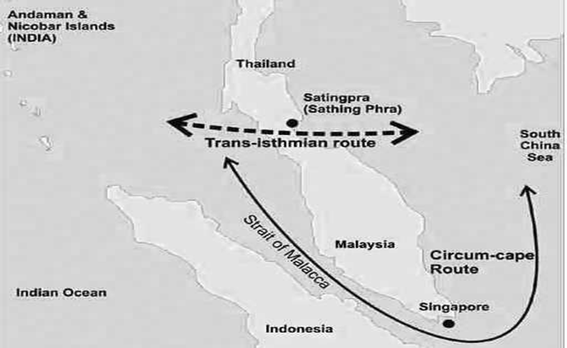
The Thai Canal would offer the shortest link between the Indian and the Pacific Oceans compared to other routes. Given the near saturation of the Malacca Strait as well as potential security and environmental risks, it is therefore unavoidable that a viable alternative shipping route has to be found sooner than later. Another serious concern is the environmental impact from oil leaks from supertankers. The strait’s shallowness reduces the sea lane to only 4 kilometres in width, making passing ships vulnerable to maritime accidents, piracy and terrorism by religious fanatics. Moreover, the shallowness of the Malacca Straits presents a problem for the oil supertankers, which need a draft of 21.2 meters. The vessels would therefore have to opt for longer alternative routes passing through the Straits of Sunda and Lombok further south unless a more feasible route through the Kra Isthmus is developed. The Malacca Strait is estimated to reach saturation in 2024 when more than 140,000 vessels seek to pass through the narrow waterway, which can only accommodate 122,640 vessels per year.

The Chinese envision the huge enterprise as a linchpin in its Belt and Road Initiative, a development strategy designed to link as many as 70 countries into a vast economic web with Beijing at the center, the land-based Silk Road meshing with the Maritime Silk Road, all focusing on connectivity and cooperation between the countries. across the Kra Isthmus in southern Thailand so that vessels sailing from the Indian Ocean to the Pacific could cut hundreds of kilometers off their voyage and avoid the Bugis pirates of Indonesia that for centuries have haunted the Strait of Malacca.Įconomically it has never made sense – until now, as China’s burgeoning maritime traffic packs the 800 km Strait, a seagoing funnel that narrows to only 64 km near Singapore, with only a half dozen kilometers of that usable because of its shallow depth.Īccordingly, Beijing signed a Memorandum of Understanding on the canal project in Guangzhou in 2015 with the China-Thailand Kra Infrastructure Investment and Development Company and Asia Union Group. On 8 December 1941 local time, just before the 7 December (Hawaii time) attack on Pearl Harbor, the Imperial Japanese Army landed near Songkhla, Thailand and Kota Bharu, Malaya, thus beginning the Pacific War, and launching both the invasion of Thailand and the Malayan campaign, the latter which culminated in the capture of Singapore.For 330 years, visionaries have thought of dredging a great canal 150 km. The Titiwangsa Mountains are to the south, 45 km (28 mi) from Songkhla. The southern part is called the Phuket chain, which is a continuation of the greater Tenasserim range, extending further northwards for over 400 km (250 mi) beyond the Three Pagodas Pass. The Kra Isthmus marks the boundary between two sections of the central cordillera, the mountain chain which runs from Tibet through the Malay peninsula. The narrowest part, between the estuary of the Kra River and the Bay of Sawi near the city Chumphon has a width of 44 km (27 mi), and has a maximum elevation of 75 m (246 ft) above sea level.

To the west of the isthmus is the Andaman Sea, and to the east is the Gulf of Thailand. The east part of the landbridge belongs to Thailand, while the west part belongs to the Tanintharyi division of Myanmar. The Kra Isthmus ( Thai : คอคอดกระ, pronounced ) is the narrowest part of the Malay Peninsula, in southern Thailand and Myanmar.


 0 kommentar(er)
0 kommentar(er)
